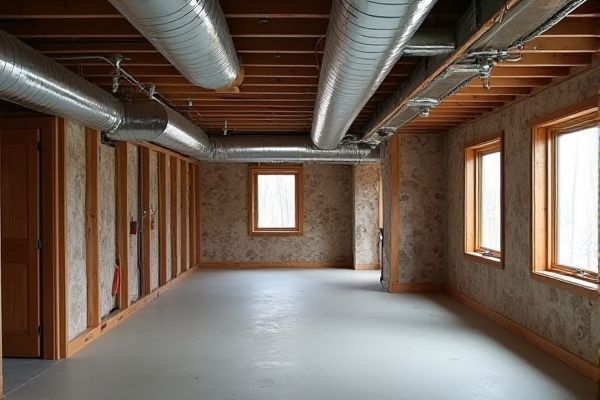
Exposed ductwork in basements offers an industrial aesthetic and easier access for maintenance, while boxed-in ductwork provides a cleaner, more finished look by concealing the ducts within drywall or wood framing. Discover the benefits and drawbacks of each option to decide which best suits Your basement renovation goals in the full article.
Table of Comparison
| Feature | Exposed Ductwork | Boxed-In Ductwork |
|---|---|---|
| Installation Cost | Lower cost; minimal materials needed | Higher cost; requires framing and drywall |
| Aesthetics | Industrial, modern look | Clean, finished appearance |
| Ceiling Height Impact | Preserves ceiling height | Reduces ceiling height due to boxing |
| Accessibility for Maintenance | Easy access for repairs and inspection | Limited access unless removable panels are included |
| Insulation and Noise | Less sound dampening; may require insulation | Better noise reduction; can conceal insulation |
| Durability | Exposed to potential damage | Protected within boxed structure |
| Design Flexibility | Limits design options; raw look | Allows for customization and integration with decor |
| Typical Use | Industrial, modern, budget-friendly basements | Traditional, finished basement designs |
Introduction to Basement Ductwork Choices
Exposed ductwork in basements offers a modern industrial aesthetic while providing easy access for maintenance and repairs. Boxed-in ductwork conceals ducts within framed walls or soffits, enhancing visual appeal and improving sound insulation. Choosing between exposed and boxed-in systems depends on priorities such as budget, design preferences, and ease of access for HVAC servicing.
What Is Exposed Ductwork?
Exposed ductwork refers to HVAC ducts that remain visible rather than being enclosed within walls or ceilings, often seen in basements with industrial or modern design aesthetics. This style allows for easier access during maintenance and can contribute to improved airflow efficiency due to minimal obstructions. Your choice between exposed and boxed-in ductwork impacts both the visual appeal and functionality of your basement's ventilation system.
What Is Boxed-In Ductwork?
Boxed-in ductwork refers to HVAC ducts enclosed within a constructed framework, typically made from drywall or wood, to create a smooth, finished appearance in basements. This method conceals the duct system, protecting it from damage and improving the overall aesthetic by hiding the industrial look of exposed metal ducts. Boxed-in ductwork can also help reduce noise and allows for easier integration with lighting or other ceiling features.
Aesthetic Appeal: Industrial vs. Concealed Look
Exposed ductwork in basements offers an industrial aesthetic characterized by raw metal surfaces and visible piping, appealing to modern loft-style designs that emphasize urban, utilitarian charm. Boxed-in ductwork provides a concealed look, creating smooth, uninterrupted ceiling lines that complement traditional or finished basement interiors by hiding mechanical elements. Choosing between exposed and boxed-in ductwork significantly impacts the visual ambiance, with exposed ducts highlighting architectural details and boxed-in solutions prioritizing clean, polished aesthetics.
Space Efficiency and Ceiling Height Impact
Exposed ductwork in basements maximizes ceiling height, creating an open and airy feel while maintaining full vertical clearance for furniture and fixtures. Boxed-in ductwork, though offering a cleaner aesthetic, reduces overall ceiling height and can make the space feel more confined, limiting your options for tall storage or lighting. Choosing exposed ducts enhances space efficiency by preserving headroom, essential for basements with already limited height.
Installation Complexity and Cost Comparisons
Exposed ductwork in basements offers simpler installation with lower labor costs, as ducts are mounted directly to ceiling joists without additional framing or drywall work. Boxed-in ductwork requires constructing soffits or bulkheads, increasing material expenses and installation time due to carpentry and finishing labor. The choice impacts overall project budgets, with exposed ducts providing a cost-effective and less complex solution compared to boxed-in systems.
Maintenance and Accessibility Considerations
Exposed ductwork in basements offers easier maintenance and accessibility since all components are visible and reachable, allowing quick inspections and repairs. Boxed-in ductwork conceals ducts behind drywall or wood, which can hinder routine maintenance and require removing panels or sections to access the system. Prioritizing exposed ductwork can save time and effort for your HVAC upkeep, improving long-term system efficiency.
Energy Efficiency and Airflow Performance
Exposed ductwork in basements enhances energy efficiency by reducing heat loss through uninsulated surfaces and allows for better airflow performance due to minimal obstructions and easier access for maintenance. Boxed-in ductwork, while offering a cleaner aesthetic, can trap heat and restrict airflow, potentially increasing energy consumption as your HVAC system works harder to circulate air. Choosing exposed ductwork optimizes HVAC efficiency and improves overall indoor air quality by maintaining consistent airflow and temperature control.
Moisture and Condensation Issues in Basements
Exposed ductwork in basements is more susceptible to moisture and condensation issues due to direct exposure to fluctuating basement humidity and temperature levels, which can lead to mold growth and corrosion. Boxed-in ductwork provides a protective barrier that minimizes condensation by insulating ducts, reducing temperature differentials between the duct surface and ambient air. Proper ventilation and vapor barriers further enhance moisture control, preventing structural damage and maintaining indoor air quality.
Choosing the Right Ductwork Style for Your Basement
Exposed ductwork in basements offers an industrial aesthetic and easier access for maintenance, while boxed-in ductwork provides a cleaner, more finished look that can improve noise reduction and insulation. Your choice depends on whether you prioritize aesthetic appeal, ceiling height preservation, or energy efficiency, as boxed-in ducts can reduce ceiling space but enhance thermal performance. Consider your basement style, budget, and maintenance preferences to select the ductwork style that best fits your space and ensures optimal airflow.
 homyna.com
homyna.com